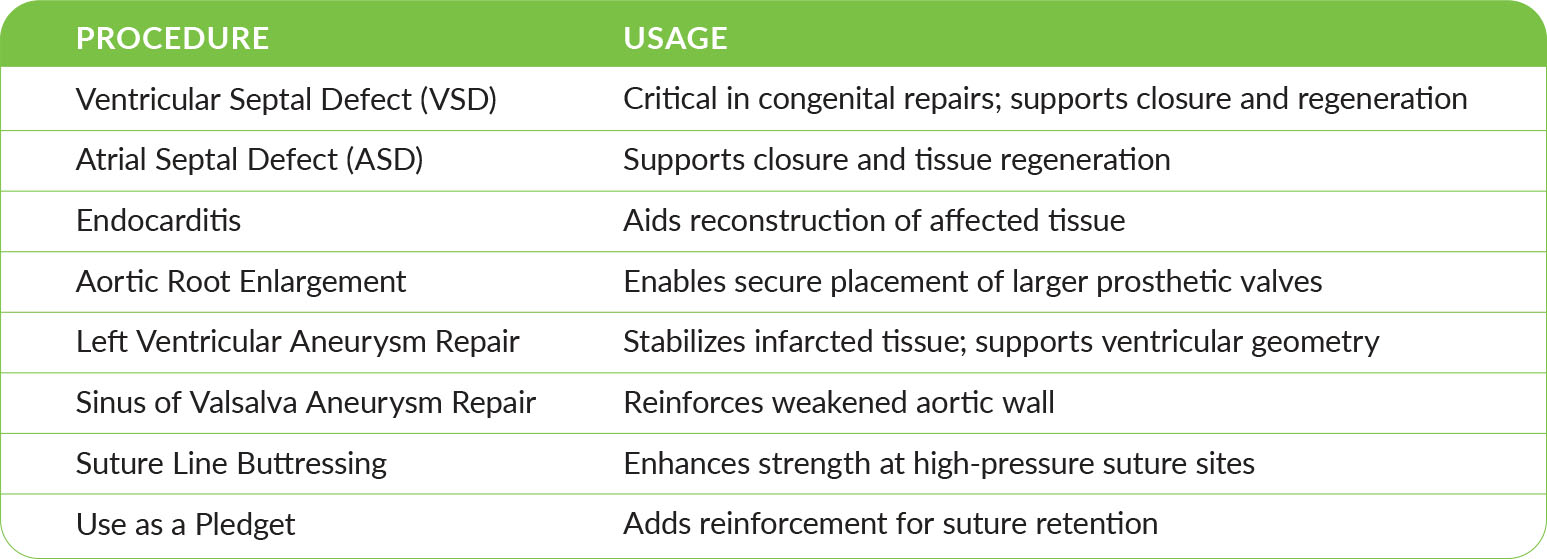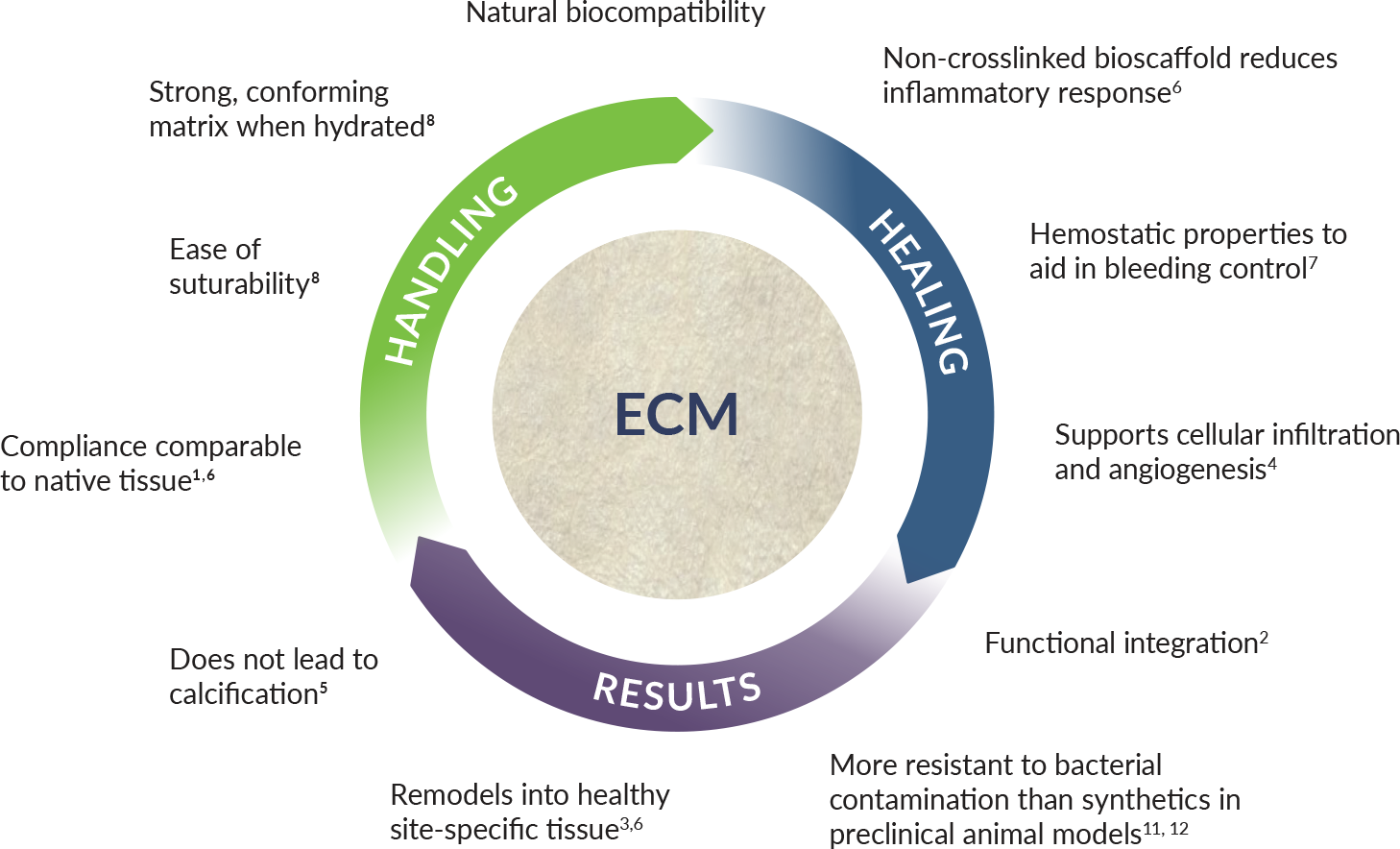

Strength and Regeneration for Intracardiac Repair. Naturally.
Engineered for Reliable Intracardiac Defect Repair1,2
- Conforms to complex intracardiac defect geometries for precise repair
- Pliable and easy to trim for tailored fit and full contact with viable tissue
- Facilitates remodeling into vascularized, functional native tissue
Promote Long-Term Healing and Patient Outcomes1,3
- Minimizes chronic inflammation and fibrotic response
- Encourages vascularized tissue ingrowth and constructive remodeling
- Enhances durability of repair through natural tissue regeneration

Supports constructive tissue remodeling
ProxiCor has shown effective tissue remodeling in challenging cases.
Aortic Root Repair4
A 90-year-old woman with critical aortic valve stenosis and a severely calcified, hypoplastic aortic root underwent surgical valve replacement. ProxiCor was used to augment the aortic root, serving as a biologic scaffold in this anatomically restricted, high-risk setting.
The patient recovered well and resumed normal activity. She passed away at age 93, and with the family’s consent, a unique opportunity arose to perform histological evaluation of the explanted ascending aorta and aortic valve.
Findings 3 Years Post-Implant
- Histology showed the ProxiCor graft was indistinguishable from native aortic tissue, confirming full incorporation.
- Microscopy revealed organized neotissue with endothelialized microvasculature and host cell repopulation, indicating regenerative healing rather than fibrosis.
- Minimal inflammatory response demonstrated excellent biocompatibility, even in an elderly patient.
- No calcium deposition was observed in the patch.
Clinical Relevance
ProxiCor provides both structural reinforcement and biologic activity, enabling durable outcomes in complex aortic reconstructions. Its use in this challenging scenario reinforces its role as a preferred biologic patch in cardiac repair—especially where healing potential is limited and surgical precision is critical.

Elutia’s Biomatrices for Cardiovascular Tissue
The Natural Choice for Repair and Regeneration
Elutia’s biomatrix portfolio is built on engineered extracellular matrix (ECM) biology—designed to facilitate surgical repair, support healing, and address key causes of complications.
Trusted in over one million patients and supported by hundreds of peer-reviewed publications, Elutia’s ECM biomatrices offer confidence in every repair.
Naturally Better
Unlike other products that are crosslinked—compromising their ability to remodel—Elutia’s biomatrices preserve what matters for healing.

Elutia’s biomatrices (ProxiCor, VasCure) have been used for valve and annular repair in patients with endocarditis, as well as in high-risk conditions such as prior infection or radiation. Though based on limited number of patients, these cases showed no infection-related failures and good tissue integration—supporting potential use in contaminated or compromised fields.7,9,10
*ProxiCor, VasCure and Tyke are not specifically cleared or indicated by regulatory authorities for the prevention or treatment of infection. Clinical judgment should guide their use in infected or high-risk surgical fields.
Trusted by surgeons. Validated by data. Naturally.
1. Piterina A, et al. Int J Mol Sci. 2009 Nov 20;10(10):4375-4417.
2. Ferng A, et al. Ann Thorac Surg. 2017 Sep;104(3):e239-e241.
3. Grimes M, et al. Biomed Mater Eng. 2005;15(1-2):65-71.
4. Slachman FN. Ann Thorac Surg. 2014;97(5):e129.
1. Allen K, et al. Front Cardiovasc Med. 2021;8:631750.
2. Bibevski S, et al. Front Cardiovasc Med. 2020;7:562136.
3. Ferng A, et al. Ann Thorac Surg. 2017;104(3):e239–e241.
4. Grimes M, et al. Biomed Mater Eng. 2005;15(1–2):65–71.
5. Haney L, et al. Ann Thorac Surg. 2021;S0003-4975(21)01384 undermann S, et al. Interact Cardiovasc Thorac Surg. 2015;20(1):10–14.
8. Elutia Data on File.
9. Myers P, et al. Circulation. 2012;126:A16130.
10. Gerdisch M, et al. J Thorac Cardiovasc Surg. 2014;148(4):1370–1378.
11. Badylak S, et al. J Biomed Mater Res B Appl Biomater. 2003;67(1):648–654.
12. Jernigan T, et al. Ann Surg. 2004;239(5):733–738.
